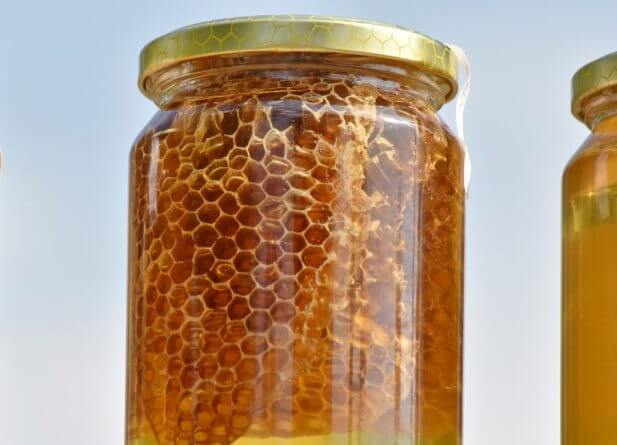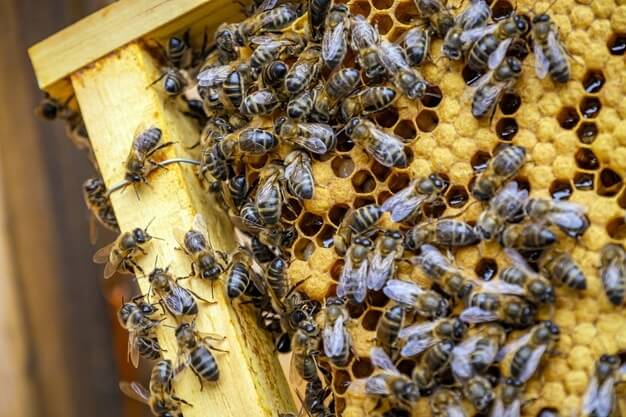Bees aren’t just the world’s most efficient pollinators. They also have a strong claim to the title of the world’s best architects and engineers.
The supporting evidence isn’t hard to find. You only need to look at the honeycomb shape — rows upon rows of hexagonal cells separated by wax walls — a stunning application of architectural geometry.
The singular shape of the honeycombs trigger some intriguing questions:
1. Why do bee cells in a honeycomb have a hexagonal shape?
2. How is a honeycomb made?
3. Is bees making honeycomb into a hexagonal shape planned or accidental?
In this guide, you’ll find the answers to all of these. But first, let’s talk about the unique structure of the hexagon honeycomb.

The honeycomb’s design
A honeycomb is a collection of rows of wax cells that are almost always built on the horizontal axis. The open ends or the top of the cells is always higher than the rear end or the bottom. The angle of the slope is typically between 9 to 14 degrees.
A typical hive comprises about 100,000 bee cells. The process of building a honeycomb typically requires about 2.6 lbs wax.
The cells, with their hexagonal prism shapes, are closely identical to one another. The straight, uniform edges ensure they fit together perfectly in rows.
Why are honeycomb cells hexagonal?
“Why do bees use hexagons?” is a question that’s intrigued scientists for decades. One of the most popular theories behind the bees’ preference for hexagons is The Honeycomb Conjecture.
According to this theory, the hexagonal design of the honeycombs enables the creation of cells that are equal in size. This structure minimizes the cells’ total perimeter.
The surface to perimeter ratio of a hexagon is the highest of all polygons. Consequently, bees are able to build the maximum number of cells with the given volume of wax if the cells are hexagonal.
In 1999, American mathematician Thomas C. Hales proved the honeycomb conjecture to be right.
How is honeycomb made?

The creation of beehives is an important part of the bees’ life cycle. Beehives offer the colony shelter, security, food, and a place to raise their young. While some bee species have been known to occupy the same hive for years, others move and build a new hive every year.
Bees build honeycombs using beeswax – a form of wax produced by the wax glands located under their stomachs. There are 8 pairs of these glands in a bee’s body. The wax is secreted through the pores on the bees’ abdomen in the form of small flecks. Bees use their legs, mandibles as well as antennae when building a honeycomb.
The freshly secreted beeswax isn’t suitable for honeycomb building. Bees have to chew on the wax until it gets soft and develops clay-like consistency. It’s common for bees to work on wax secreted by other bees to help it achieve the desired texture.
The creation of a honeycomb requires three building materials:
1. Beeswax
2. Bee saliva
3. Propolis or be glue – a binding substance prepared by bees using plant resin, wax, and saliva.
The worker bees line the walls of the cells with a thin film of propolis. Next, they work on converting beeswax into small bits of bonding material.
Here are some interesting facts about the construction of honeycombs:
- A bee needs to consume about 8 ounces of honey for producing an ounce of beeswax.
- A honeycomb is capable of supporting about 30 times the weight of a single bee.
- The temperature inside the beehive plays a crucial role in the construction of a honeycomb. Bees regulate the temperature by crowding together until the wax is the ideal consistency for building cells.
- Honeycombs have designated levels for storing different materials. The uppermost rows of cells are used for storing honey. The rows underneath store the pollen. The rows below the pollen reserves house the worker brood, followed by the drone brood cells. The queen bee resides at the very bottom.
Do bees build hexagonal cells by design?
The ancients believed they did. Alexandrian mathematician Pappus opined that bees “possess a divine sense of symmetry”. Beeswax is a precious resource. It’s believed that bees aim for optimal material efficiency by building cells in a shape that requires the least amount of beeswax.
There is, however, another explanation why the honeycomb structure is hexagonal. Observing the bees at work has revealed that the cells are circular during the early stages of construction.
A large number of bees working close together raises the temperature inside the hive. This heat causes the wax to melt, flattening the walls and creating a hexagonal shape. This suggests that the final shape of the cells could be accidental.
Bees are exceptionally deliberate. They’ve been known to crawl inside every cell to measure it using their own bodies. They’ve also been known to alter the cells’ tilt to prevent leakage of honey. The generation of heat to melt the cell walls, therefore, could well be a calculated move.
In this article, we’ve solved the big mystery – Why do bees make hexagons? We’ve also:
- Discussed the purpose and process of honeycomb creation.
- Shared some remarkable facts about the bees and honeycombs.
Whether the bee’s preference for hexagons is by design or accident is something science has yet to fully decipher. Whatever the case, it can’t take away from the amazing, inspirational work ethic of these tiny creatures – a thing we should all aspire to emulate.